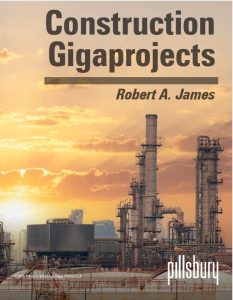In our latest roundup, lab space real estate faces challenges, demand for data creates power brokers, the cost burden of sports stadiums, and more!
New California Law Imposes a Five Percent Cap on Retention for Private Works of Improvement
Most private construction contracts executed on or after January 1, 2026, must limit progress payment retention to five percent or less under a new law that goes into effect on the first of the year in California. This requirement applies to retention withheld by an owner from the direct contractor, by the direct contractor from any subcontractor, and by any subcontractor from any lower-tier subcontractor.
CARB Publishes Preliminary List of Entities Subject to Climate Disclosure Rules
 The California Air Resources Board (CARB) released a preliminary list of companies it believes may be subject to the state’s new climate disclosure regime, which imposes significant disclosure duties on large United States entities “doing business in California”—even if the business they do in California is not itself large. CARB’s list comes after a federal trial court declined to stay the rules, with the first compliance deadline set to go into effect January 2026 even as the agency’s implementing regulations remain under development.
The California Air Resources Board (CARB) released a preliminary list of companies it believes may be subject to the state’s new climate disclosure regime, which imposes significant disclosure duties on large United States entities “doing business in California”—even if the business they do in California is not itself large. CARB’s list comes after a federal trial court declined to stay the rules, with the first compliance deadline set to go into effect January 2026 even as the agency’s implementing regulations remain under development.
DOE Issues First Solicitation for AI Data Center and Energy Co-Location on Designated Federal Land
On September 8, 2025, the U.S. Department of Energy (DOE) issued a Request for Applications (RFA) seeking proposals from U.S. companies to develop AI data centers co-located with advanced energy projects at the Idaho National Laboratory. This RFA follows the Administration’s July Executive Order on accelerating AI data center infrastructure and DOE’s designation of four federal sites for such projects. At the Idaho National Laboratory, DOE is specifically looking for proposals to potentially enter into long-term leasing agreements at the site. Applications that integrate innovative energy generation and storage with AI data centers will receive priority consideration, including technologies such as advanced nuclear reactors, enhanced geothermal systems, and cold underground thermal energy storage.
Climate Superfund Litigation: Courts Split on Venue and Intervention in New York and Vermont Cases
Coalitions of Republican-led states, industry associations led by the U.S. Chamber of Commerce, and, most recently, the U.S. Department of Justice are testing “climate superfund” laws that aim to recover billions from carbon majors for climate adaptation costs. Recent rulings in lawsuits challenging the New York and Vermont statutes have split cases across courts and reached opposite outcomes on intervention: In New York, cases are being split between the Northern and Southern Districts and intervention efforts by nonprofits have been blocked, while in Vermont, the district court has allowed environmental organizations to join the defense of the statutes in two cases.
Satellite Data Centers
How did the “final frontier” become a genuine consideration for siting and constructing next-generation data centers? Perhaps it is the inevitable result of demand greatly outstripping supply in two of the great pillars of the data center ecosystem: real estate and power supply. As Pillsbury recently reported in the Pillsbury Guide to Data Centers, some 11,800 data centers were reported to already be operating worldwide in 2024. Yet the demand for centers is expected to rise by as much as 22% annually until 2030, placing significant constraints on the ability of operators to locate sufficient real estate to build and operate them all, obtain the necessary permits for construction and operation on a timely basis, and, significantly, ensure the availability and reliability of electricity to power and cool the components. Or perhaps growing concerns over security, resiliency and environmental impacts are driving operators and users to look for alternative solutions.
The Supreme Court’s Administrative and Regulatory Law Rulings in the 2024 Term and Preview of Cases to Be Decided in Fall 2025
This post reviews the U.S. Supreme Court’s significant regulatory and administrative law decisions from the Court’s 2024 Term and previews cases on the docket for Fall 2025. While the term produced no true “blockbusters,” the Court displayed particular concern with how lower federal courts have been applying the National Environmental Policy Act (NEPA), and it clarified the already complex judicial review provisions of the Clean Air Act (CAA). At the same time, the Court declined invitations to revisit contentious issues surrounding CAA citizen suits and avoided intervening in the wave of state-law climate change litigation. Consistent with its current composition, the Court continues to take a conservative approach, closely hewing to statutory text and structure.
Our review is organized in three parts: first, environmental and energy law cases; second, administrative law rulings that delineate the boundaries of the Administrative Procedure Act (APA); third, we discuss the environmental, energy and administrative law cases the Court has agreed to hear in its October 2025 Term.
Executive Order 14275: Restoring Common Sense to Federal Procurement
Under the President’s Executive Order 14275: Restoring Common Sense to Federal Procurement, the government is undertaking a comprehensive overhaul of the Federal Acquisition Regulation (FAR). Led by the Office of Federal Procurement Policy (OFPP) and the Federal Acquisition Regulatory Council (FAR Council), the initiative aims to “return the FAR to its statutory roots,” regulate in plain language, and remove superfluous words and references. On August 27, the FAR Council released its revisions to FAR Part 33, which addresses Bid Protests, Contract Claims and Appeals of Contract Claims. We completed our deep dive into the Subpart 33.2 portion of the rewrite, which addresses claims and appeals. Construction companies that perform government contracts should welcome the changes rather than fear them.
Federal Court Halts Enforcement of Texas SB 2337 Regarding Proxy Advisor Disclosure of ESG or Other “Nonfinancial” Considerations
Enacted earlier this year and scheduled to take effect September 1, SB 2337 would impose new disclosure obligations on proxy advisory firms issuing recommendations regarding Texas-based public companies, including a requirement that any recommendation based in whole or in part on environmental, social, or governance (ESG) or other “nonfinancial” considerations be accompanied by a disclaimer that such advice subordinates shareholder financial interests to other objectives. But, on August 29, 2025, Judge Alan Albright of the U.S. District Court for the Western District of Texas entered preliminary injunctions in two related cases enjoining the State from enforcing Senate Bill 2337 against Institutional Shareholder Services (ISS) and Glass Lewis, the two firms that together account for the vast majority of proxy advisory services in the U.S. While the injunctions technically apply only to the named plaintiffs, their market dominance—an estimated 97 percent of proxy advisory services—renders the orders functionally dispositive of the law’s near-term enforceability.
The Construction Gigaprojects Report
 Construction “gigaprojects” are initiatives with expenses of well over $1 billion and which involve time periods of well over five years. They are engagements whose extraordinary size, duration and complexity might induce even the most seasoned of project professionals to rethink how they “do contracts.” The prospect of a gigaproject does not so much raise new questions as call for the careful reconsideration of otherwise established answers. What alternative forms of contracting might one use, how might they allocate economic and project risks, and what compensation might drive the parties’ behavior?
Construction “gigaprojects” are initiatives with expenses of well over $1 billion and which involve time periods of well over five years. They are engagements whose extraordinary size, duration and complexity might induce even the most seasoned of project professionals to rethink how they “do contracts.” The prospect of a gigaproject does not so much raise new questions as call for the careful reconsideration of otherwise established answers. What alternative forms of contracting might one use, how might they allocate economic and project risks, and what compensation might drive the parties’ behavior?





